Click here for a printable PDF of this article.
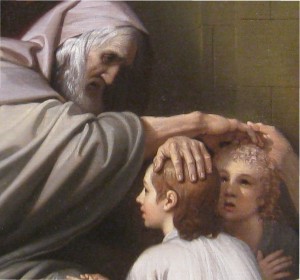 This week’s Torah portion tells us of the last days of Jacob, the third of our forefathers. When it was clear that Jacob did not have much longer to live, Jacob’s son Joseph brought his own adult sons, Ephraim and Manasseh, to visit their grandfather for the last time. Jacob took this visit as an opportunity to bless his grandchildren. Though the custom when giving a blessing to two people at once was to place the right hand on the head of the older person and the left hand on the head of the younger person, Jacob did the opposite. He placed his right hand on the head of Ephraim, the younger of the two brothers, and his left hand on the head of Manasseh, the older brother. Joseph, thinking his father had made a mistake, tried correcting him, but Jacob told him that it was no mistake. He had seen prophetically that though great people would descend from both of these grandsons, the descendants of Ephraim would be greater. He therefore accorded Ephraim the honor generally given to the older sibling.
This week’s Torah portion tells us of the last days of Jacob, the third of our forefathers. When it was clear that Jacob did not have much longer to live, Jacob’s son Joseph brought his own adult sons, Ephraim and Manasseh, to visit their grandfather for the last time. Jacob took this visit as an opportunity to bless his grandchildren. Though the custom when giving a blessing to two people at once was to place the right hand on the head of the older person and the left hand on the head of the younger person, Jacob did the opposite. He placed his right hand on the head of Ephraim, the younger of the two brothers, and his left hand on the head of Manasseh, the older brother. Joseph, thinking his father had made a mistake, tried correcting him, but Jacob told him that it was no mistake. He had seen prophetically that though great people would descend from both of these grandsons, the descendants of Ephraim would be greater. He therefore accorded Ephraim the honor generally given to the older sibling.
The Torah then records the blessing that Jacob proceeded to give Ephraim and Manasseh: “By you shall Israel bless, saying, ‘May God make you like Ephraim and Manasseh.’” The blessing that Jacob was giving to his grandsons was that all future generation would bless their children that they grow up to be like Ephraim and Manasseh. Jacob’s blessing has been and continues to be fulfilled. To this day, when Jewish parents give their sons a blessing, either weekly on Friday night or annually before Yom Kippur, the text of the traditional blessing is, “May God make you like Ephraim and Manasseh.”
Why is this so? We bless our daughters that they should follow in the footsteps of our glorious Matriarchs (“May God make you like Sarah, Rebecca, Rachel, and Leah”), so why did Jacob not want us to bless our sons that they follow in the path of our Patriarchs? What is unique about Ephraim and Manasseh that Jacob was essentially hoping and praying that all of his male descendants should follow in the path of these two grandchildren of his? Continue reading Parshat Vayechi – Peace: The Ultimate Blessing →
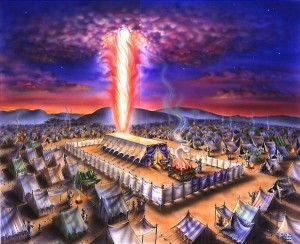 We have spent the past few weeks following the conversation between God and Moses as to how to build the Tabernacle, its vessels, and the priestly clothing. This week, the Torah tells us that Moses appointed Betzalel to lead the building project. Throughout the parshah, as the Torah describes the actual construction of the Tabernacle, it continually states, “such and such was done as God commanded Moses.” Why, while discussing the topic of the Tabernacle, does the Torah stress that everything was done, “as God commanded Moses,” more than any other part of the Torah? Continue reading Parshat Pekudei – Our Moral Compass
We have spent the past few weeks following the conversation between God and Moses as to how to build the Tabernacle, its vessels, and the priestly clothing. This week, the Torah tells us that Moses appointed Betzalel to lead the building project. Throughout the parshah, as the Torah describes the actual construction of the Tabernacle, it continually states, “such and such was done as God commanded Moses.” Why, while discussing the topic of the Tabernacle, does the Torah stress that everything was done, “as God commanded Moses,” more than any other part of the Torah? Continue reading Parshat Pekudei – Our Moral Compass  There have been many comparisons drawn between the Purim story that we are in the midst of celebrating and the historical events that are currently playing out on the world stage. In the Purim story, the Jewish nation was faced with an existential threat emanating from the ancient Persian Empire. Today, the Jewish nation is once more facing an existential threat from the modern day Persian Empire, Iran, this time in the form of potential nuclear weapons. In the Purim story, a Jewish leader, Esther, accepted upon herself to break protocol and appear before the King, unsummoned, in order to plead on behalf of her people. Today, a Jewish leader, Benjamin Netanyahu, broke protocol and appeared in the chambers of the US Congress to plead on behalf of his people.
There have been many comparisons drawn between the Purim story that we are in the midst of celebrating and the historical events that are currently playing out on the world stage. In the Purim story, the Jewish nation was faced with an existential threat emanating from the ancient Persian Empire. Today, the Jewish nation is once more facing an existential threat from the modern day Persian Empire, Iran, this time in the form of potential nuclear weapons. In the Purim story, a Jewish leader, Esther, accepted upon herself to break protocol and appear before the King, unsummoned, in order to plead on behalf of her people. Today, a Jewish leader, Benjamin Netanyahu, broke protocol and appeared in the chambers of the US Congress to plead on behalf of his people. two layers of gold. There were two cherubs attached to the cover of the Ark. There were two tablets placed within the Ark. What is the meaning of this theme?
two layers of gold. There were two cherubs attached to the cover of the Ark. There were two tablets placed within the Ark. What is the meaning of this theme?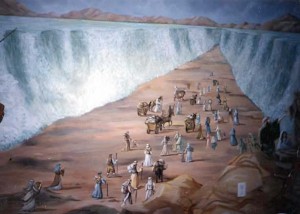 The very first conversion to Judaism takes place in this week’s parshah. The Torah relates that Yitro (Jethro), the father-in-law of Moses, traveled from Midyan to join the Jewish people. The Talmud explains that there were two events that prompted him to convert. The first catalyst was hearing of the miraculous splitting of the Yam Suf, the Red Sea. The second was hearing about the war with the nation of Amalek that took place at the end of last week’s parshah.
The very first conversion to Judaism takes place in this week’s parshah. The Torah relates that Yitro (Jethro), the father-in-law of Moses, traveled from Midyan to join the Jewish people. The Talmud explains that there were two events that prompted him to convert. The first catalyst was hearing of the miraculous splitting of the Yam Suf, the Red Sea. The second was hearing about the war with the nation of Amalek that took place at the end of last week’s parshah.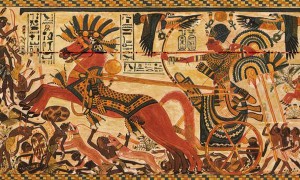 Only five days after the Jewish people were dramatically emancipated from the cruel Egyptian slavery, Pharaoh had a sudden change of heart and regretted sending the Jews away. Intending to force them to return and to subjugate them to slavery once more, he gathered his men and chased after the nascent nation. Having tasted a mere five days of freedom, the Jewish people found an Egyptian army bearing down upon them and almost overtaking them.
Only five days after the Jewish people were dramatically emancipated from the cruel Egyptian slavery, Pharaoh had a sudden change of heart and regretted sending the Jews away. Intending to force them to return and to subjugate them to slavery once more, he gathered his men and chased after the nascent nation. Having tasted a mere five days of freedom, the Jewish people found an Egyptian army bearing down upon them and almost overtaking them.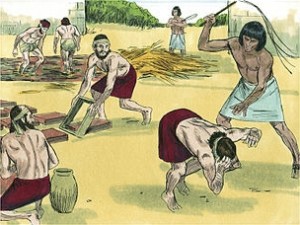
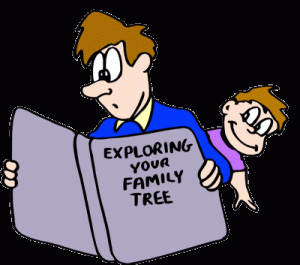 The highpoint of the redemption is about to begin. But wait! The Torah interrupts the story just as the narrative is reaching its climax with seemingly mundane, unrelated details: the genealogy of Moses and Aaron. Why interrupt the storyline at its most suspenseful moment with this unnecessary information?
The highpoint of the redemption is about to begin. But wait! The Torah interrupts the story just as the narrative is reaching its climax with seemingly mundane, unrelated details: the genealogy of Moses and Aaron. Why interrupt the storyline at its most suspenseful moment with this unnecessary information? 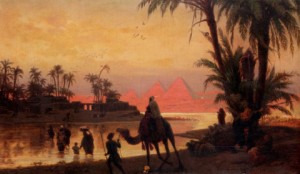 Pharaoh’s astrologers informed him that a boy would be born who would redeem the Jewish people from Egyptian slavery. He therefore enacted a new decree that all male newborns would be drowned in the Nile River. At this point in the story, the Torah tells us that ‘A man went from the house of Levi and married a daughter of Levi.’ This man was Amram. The ‘daughter of Levi’ was Jochebed.
Pharaoh’s astrologers informed him that a boy would be born who would redeem the Jewish people from Egyptian slavery. He therefore enacted a new decree that all male newborns would be drowned in the Nile River. At this point in the story, the Torah tells us that ‘A man went from the house of Levi and married a daughter of Levi.’ This man was Amram. The ‘daughter of Levi’ was Jochebed. Pharaoh’s henchmen would find and kill the baby. He therefore divorced his wife. As Amram was the leader of the Jewish people at the time, all the rest of the Jews followed suit and divorced their wives. Miriam, who at the time was a mere six years old, understood the situation and recognized the obvious outcome of her father’s decision: no more Jewish children. Disagreeing with her father, she presented him with the following three arguments as to why he should stay married:
Pharaoh’s henchmen would find and kill the baby. He therefore divorced his wife. As Amram was the leader of the Jewish people at the time, all the rest of the Jews followed suit and divorced their wives. Miriam, who at the time was a mere six years old, understood the situation and recognized the obvious outcome of her father’s decision: no more Jewish children. Disagreeing with her father, she presented him with the following three arguments as to why he should stay married: This week’s Torah portion tells us of the last days of Jacob, the third of our forefathers. When it was clear that Jacob did not have much longer to live, Jacob’s son Joseph brought his own adult sons, Ephraim and Manasseh, to visit their grandfather for the last time. Jacob took this visit as an opportunity to bless his grandchildren. Though the custom when giving a blessing to two people at once was to place the right hand on the head of the older person and the left hand on the head of the younger person, Jacob did the opposite. He placed his right hand on the head of Ephraim, the younger of the two brothers, and his left hand on the head of Manasseh, the older brother. Joseph, thinking his father had made a mistake, tried correcting him, but Jacob told him that it was no mistake. He had seen prophetically that though great people would descend from both of these grandsons, the descendants of Ephraim would be greater. He therefore accorded Ephraim the honor generally given to the older sibling.
This week’s Torah portion tells us of the last days of Jacob, the third of our forefathers. When it was clear that Jacob did not have much longer to live, Jacob’s son Joseph brought his own adult sons, Ephraim and Manasseh, to visit their grandfather for the last time. Jacob took this visit as an opportunity to bless his grandchildren. Though the custom when giving a blessing to two people at once was to place the right hand on the head of the older person and the left hand on the head of the younger person, Jacob did the opposite. He placed his right hand on the head of Ephraim, the younger of the two brothers, and his left hand on the head of Manasseh, the older brother. Joseph, thinking his father had made a mistake, tried correcting him, but Jacob told him that it was no mistake. He had seen prophetically that though great people would descend from both of these grandsons, the descendants of Ephraim would be greater. He therefore accorded Ephraim the honor generally given to the older sibling.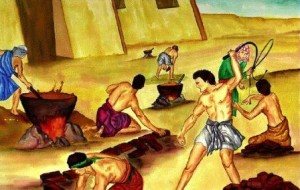 In another few months, we will reach the holiday of Passover, celebrating our redemption from Egyptian slavery. We will spend two long seder nights amid eight complete days thanking God for liberating us from the terrible oppression that we faced in Egypt. But wait a second – who sent us down there in the first place? Jacob and his children emigrate from Canaan (Israel) to Egypt in this week’s parshah, and the Torah is very clear that God wanted them to go. As a matter of fact, two generations earlier God had already informed Abraham that his children would be exiled to Egypt and that it would be there that they would develop from just a family into an entire nation. Why did we ever have to leave Canaan? Why couldn’t we transition into nationhood in our own land?
In another few months, we will reach the holiday of Passover, celebrating our redemption from Egyptian slavery. We will spend two long seder nights amid eight complete days thanking God for liberating us from the terrible oppression that we faced in Egypt. But wait a second – who sent us down there in the first place? Jacob and his children emigrate from Canaan (Israel) to Egypt in this week’s parshah, and the Torah is very clear that God wanted them to go. As a matter of fact, two generations earlier God had already informed Abraham that his children would be exiled to Egypt and that it would be there that they would develop from just a family into an entire nation. Why did we ever have to leave Canaan? Why couldn’t we transition into nationhood in our own land? 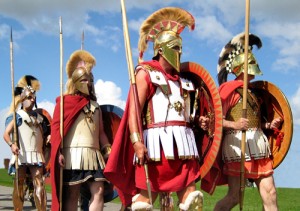 The Greeks enacted a number of decrees in order to prevent the Jews from practicing Judaism and to encourage them to accept their hedonistic perspective. According to the Midrash, one unusual edict required all Jews to inscribe on the horn of an ox the words, “I renounce my relationship with the God of Israel.” The Midrash explains that this law in particular “darkened the eyes of the Jewish people”.
The Greeks enacted a number of decrees in order to prevent the Jews from practicing Judaism and to encourage them to accept their hedonistic perspective. According to the Midrash, one unusual edict required all Jews to inscribe on the horn of an ox the words, “I renounce my relationship with the God of Israel.” The Midrash explains that this law in particular “darkened the eyes of the Jewish people”. The Greeks outlawed keeping Shabbos. They forbade Brit Milah. They wouldn’t allow the Jews to study the Torah. Yet this requirement to write that they have no connection to the God of Israel is what finally “got to” the Jews. Why did they find this particular edict to be so unbearably harsh, so much more than the others? Surely the other decrees were far more severe and really struck at the core of Judaism more than this one.
The Greeks outlawed keeping Shabbos. They forbade Brit Milah. They wouldn’t allow the Jews to study the Torah. Yet this requirement to write that they have no connection to the God of Israel is what finally “got to” the Jews. Why did they find this particular edict to be so unbearably harsh, so much more than the others? Surely the other decrees were far more severe and really struck at the core of Judaism more than this one.